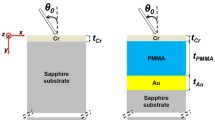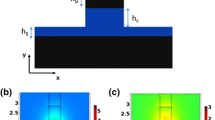Abstract
If the metal cladding of a dielectric optical waveguide is sufficiently thin to be only partially reflecting, then the waveguide modes differ from those of the conventional metal-clad waveguide. The TE modes are little affected by a variation in the metal thickness but the TM modes change considerably due to a coupling between the waveguide modes and the surface plasma waves supported by both the metal: dielectric interfaces and the metal film. It is the refractive index of the dielectric cladding which is remote from the guiding core that determines whether the lowest order TM mode is the TM0 or TM1 mode. This dielectric cladding also strongly influences the attenuation of the TM modes and, if the guide supports a TM0 mode, then the attenuation of the TM modes far from cut-off are an order of magnitude higher than that of the corresponding modes when the guide cannot support a TM0 mode. If the guide can support a TM0 mode then its dimensions can be chosen such that it will support the TEN and TMN modes with equal phase velocities. A lossless approximation is used to develop an expression which will specify the required guide dimensions directly and parametric plots of these dimensions are discussed.
Similar content being viewed by others
References
T. Takano andJ. Hamasaki,IEEE J. Quant. Electron. QE-8 (1972) 206–12.
A. Otto andW. Sohler,Optics Commun. 3 (4) (1971) 254–8.
T. E. Batchman andS. C. Rashleigh,IEEE J. Quant. Electron. QE-8 (1972) 848–50.
A. Reisinger,Appl. Optics 12 (1973) 1015–25.
I. P. Kaminow, W. L. Mammel andH. P. Weber,ibid 13 (1974) 396–405.
S. C. Rashleigh,ibid 15 (1976).
J. N. Polky andG. L. Mitchell,J. Opt. Soc. Am. 64 (1974) 274–9.
S. C. Rashleigh,Opt. Quant. Elect. 8 (1976) 49–60.
Y. Yamamoto., T. Kamiya andH. Yanai,IEEE J. Quant. Electron. QE-11 (1975) 729–36.
J. Ward, Weapons Research Establishment, Department of Manufacturing Industry, Australian Government, South Australia, private communication.
D. E. Gray., ED.,American Institute of Physics Handbook (McGraw-Hill, New York, 1963) pp. 6.103–6.122.
S. C. Rashleigh, Ph.D Dissertation, University of Queensland, Brisbane, Australia, 4067, 1975.
H. E. M. Barlow andA. C. Cullin,Proc. IEE 100 part (iii), no. 68 (1953) 329–41.
P. M. Van Den Berg andJ. C. M. Borburgh,Appl. Phys. 3 (1974) 55–60.
A. Otto,Z. Physik 216 (1968) 398–409.
Idem, ibid 219 (1969) 227–33.
R. E. Gollin,Field Theory of Guided Waves (McGraw-Hill, New York, 1960) Ch.11.
S. C. Rashleigh,Opt. Quant. Elect. 8 (1976) 241–53.
Author information
Authors and Affiliations
Rights and permissions
About this article
Cite this article
Rashleigh, S.C. A partially reflecting metal cladding: its effect on the modes of dielectric optical waveguides. Opt Quant Electron 8, 433–452 (1976). https://doi.org/10.1007/BF00624834
Received:
Issue Date:
DOI: https://doi.org/10.1007/BF00624834




